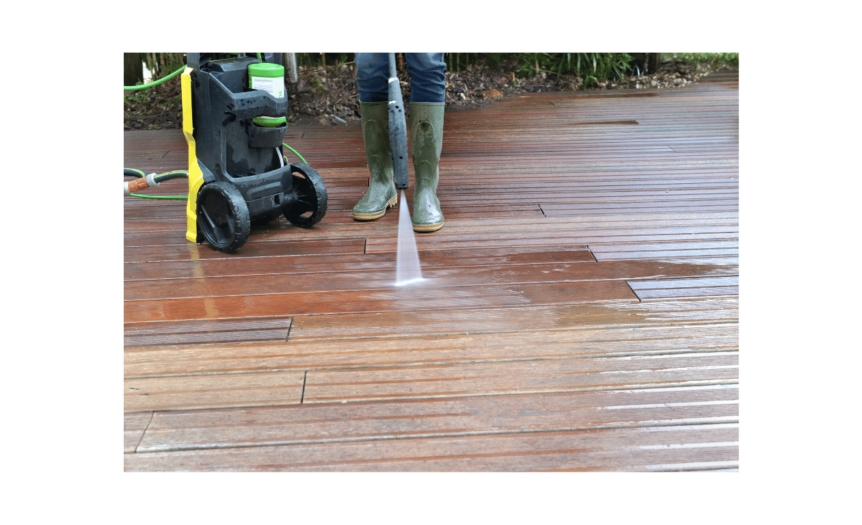Introduction
Is your patio looking a little worse for wear? Covered in a layer of grime, stubborn stains, or even unwelcome guests like mold and mildew? Don’t despair! There’s a powerful solution waiting to transform your outdoor space: pressure washing.
Pressure washing stands out as a transformative tool that can unlock the hidden potential of your patio. Imagine sparkling clean surfaces, vibrant colors restored, and a welcoming outdoor oasis ready for entertaining or simply enjoying a quiet moment of relaxation.
Whether you do it yourself or tap a pressure washing company, discover the remarkable benefits of pressure washing your patio. We’ll explore how it not only enhances the aesthetics but also protects your investment, extends the lifespan of your patio materials, and even boosts your home’s curb appeal.
The Basics of Pressure Washing
The Equipment
Pressure Washer
This is the heart of the operation. Choose between electric (great for smaller jobs) or gas-powered (more power for larger areas). Consider PSI (pressure per square inch) – higher PSI offers more cleaning power but requires more caution.
Nozzles
Different nozzles create different spray patterns. A wider fan nozzle is good for general cleaning, while a narrow jet nozzle is ideal for tougher stains.
Safety Gear
Protect yourself with goggles, gloves, and sturdy footwear. A respirator might be necessary for dusty environments.
The Process
Preparation
Clear the area of furniture and plants. Cover windows and delicate areas with plastic sheeting.
Set-Up
Connect the hose, choose the appropriate nozzle, and familiarize yourself with the pressure washer’s controls.
Cleaning
Start with a low-pressure setting and test on a small, inconspicuous area. Work from top to bottom to avoid streaking. Adjust pressure and nozzle angles as needed.
Rinsing
After cleaning, thoroughly rinse the area with clean water to remove any remaining dirt or soap residue.
Safety Tips
Maintain a safe distance.
Always follow the manufacturer’s recommendations for distance based on the nozzle and surface material.
Never point directly at yourself or others.
The forceful water stream can cause serious injury.
Be cautious with delicate surfaces.
High pressure can damage wood, vinyl siding, or windows. Adjust settings accordingly.
Read the manual
Each pressure washer has specific instructions for operation and safety features.
Assessing Your Patio’s Needs
Do Some Inspection
Surface Material
Identify the type of material your patio is made of (concrete, pavers, flagstone, etc.). This will determine the appropriate pressure setting and cleaning methods. Different materials have varying levels of pressure tolerance.
Severity of Grime
Assess the level of dirt, grime, mold, mildew, or stains on the surface. Are there light surface deposits or heavy build-up requiring stronger cleaning power?
Damage Assessment
Look for any cracks, chips, or loose pavers. Pressure washing can worsen existing damage, so it’s important to address any cracks or loose material beforehand.
Presence of Organic Growth: Check for moss, algae, or weeds growing between pavers or in cracks. Pressure washing can remove some organic growth, but persistent cases might require additional treatment.
Weather Conditions
Avoid pressure washing in direct sunlight or high heat, as it can cause the cleaning solution to dry too quickly and become less effective. Choose a mild, cloudy day.
Wind Direction
Be mindful of wind direction to avoid spraying dirt or debris onto nearby windows, plants, or furniture.
Drainage
Ensure your patio has proper drainage to prevent water pooling. If unsure, consult a professional about addressing drainage issues before pressure washing.
Addressing Specific Patio Surfaces
|
Surface |
Pressure Setting |
Cleaning Method |
Considerations |
|
Concrete |
Medium to high pressure (adjust based on severity of grime). |
Use a fan nozzle for general cleaning. A pointed nozzle can tackle stubborn stains, but be cautious and maintain a safe distance to avoid etching the surface. |
Concrete is generally quite durable, but avoid using extremely high-pressure settings or focusing on a a single spot for too long, as this can erode the surface. Pre-treat oil stains with a degreaser before pressure washing. |
|
Pavers |
Low to medium pressure (depending on the material and the paver’s interlocking system). |
Use a fan nozzle at a low angle to avoid dislodging pavers. Be mindful of the gaps between pavers, as stubborn dirt can accumulate there. Consider a rotating nozzle attachment for a more thorough cleaning. |
Interlocking pavers can be susceptible to damage at high pressures. Test a small inconspicuous area first. Use a sand-filling product specifically designed for pavers to address gaps that widen after cleaning. |
|
Flagstone |
Low pressure (flagstone is a natural stone and can be more delicate). |
Use a wide fan nozzle at a low angle. Consider a soft wash attachment for a gentler clean, especially for older or more porous flagstone. |
Flagstone can be uneven and susceptible to cracking at high pressures. Be extra cautious and avoid direct blasting on edges or corners. |
|
Wood |
Very low pressure (wood is susceptible to water damage). |
Use a wide fan nozzle at the lowest effective pressure setting. Consider a wood cleaner attachment specifically designed for pressure washing decks and patios. |
Wood requires the most delicate approach. High pressure can splinter or damage the wood fibers. Pre-wet the wood before cleaning to minimize water absorption. Always ensure proper drainage after cleaning to prevent wood rot. |
Tips for Maintaining Long-Term Results
Regular Cleaning:
Low-Pressure Maintenance Washes
Schedule regular (ideally every 6 months to a year) low-pressure washes to remove accumulated dirt and prevent grime buildup. This will lessen the need for a more intense pressure washing session later.
Spot Cleaning
Address spills, stains, and minor dirt build-up promptly.

The quicker you tackle them, the easier they are to remove and the less likely they are to become permanent eyesores.
Environmental Protection:
Minimize Mold and Mildew Growth
Address the root cause of mold and mildew growth by addressing moisture issues around your home. Fix leaky gutters, trim overgrown landscaping that shades walls, and improve ventilation.
Algae Control
For patios prone to algae growth, consider using a diluted bleach solution (always wear proper safety gear when using bleach!) after pressure washing. Be sure to rinse thoroughly to remove any remaining bleach residue.
Surface Maintenance
Resealing (Concrete and Pavers)
Over time, concrete and some pavers lose their sealant, allowing dirt and moisture to penetrate. Re-seal your patio every few years (depending on the material and climate) to maintain its beauty and protect it from damage.
Wood Staining and Sealing
For wooden patios, regular staining and sealing are crucial to maintain their appearance and prevent water damage. Follow the manufacturer’s recommendations for the type of stain and sealer appropriate for your specific wood type.
Safety First, Sustainability Always: Essential Considerations for Pressure Washing
Safety Measures:
Gear Up
Protect yourself with essential equipment. Wear safety goggles, gloves with good grip (ideally with rubberized palms), and sturdy footwear with slip-resistant soles.
Maintain Distance
Always keep a safe distance from the surface you’re cleaning, following the manufacturer’s recommendations for the specific nozzle and pressure setting.
Never Point at Yourself or Others
The forceful water stream can cause serious injury. Treat the pressure washer with respect and never point it directly at yourself, bystanders, pets, or windows.
Beware of Electrical Hazards
If using an electric pressure washer, ensure all connections are secure and avoid using it in wet conditions. Consider using a GFCI (Ground Fault Circuit Interrupter) outlet for added protection.
Read the Manual
Each pressure washer has specific instructions and safety features. Take the time to thoroughly read the manual before operating the equipment.
Environmental Considerations:
Choose Eco-Friendly Cleaning Solutions
Many commercially available cleaning solutions contain harsh chemicals that can harm plants and pollute waterways. Opt for biodegradable cleaning solutions specifically designed for pressure washing.
Minimize Water Usage
Pressure washing uses a significant amount of water. Consider using a water collection system to capture the runoff and reuse it for watering plants or washing your car.
Direct the Spray Away from Drains and Waterways
Dirt, grime, and cleaning solution runoff can contaminate storm drains and eventually pollute waterways. Be mindful of where you direct the spray and consider using a tarp or directing the runoff towards a contained area (with local regulations permitting).
Dispose of Waste Properly
Never dispose of leftover cleaning solution or collected debris down the drain. Follow local regulations for the disposal of cleaning solutions and any collected waste materials.
Conclusion
So there you have it! Pressure washing isn’t just about aesthetics; it’s a transformative tool that unlocks the hidden potential of your patio. From shielding it from damage to boosting its curb appeal, pressure washing offers a powerful cleaning solution with lasting benefits. Now, imagine yourself enjoying a refreshing beverage on a sparkling clean patio, a place that reflects not only your design taste but also your commitment to care. Take the first step – grab your pressure washer (or call a professional) – and unleash the true beauty of your outdoor oasis. Remember, a clean patio translates to a more inviting space, increased enjoyment, and ultimately, a higher value for your property. So, why wait? Unleash the power of pressure washing and let your patio shine!










